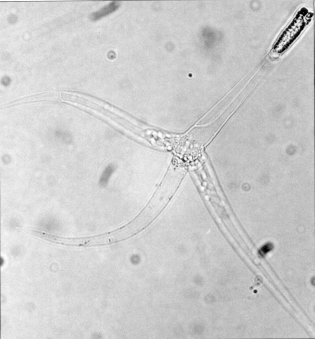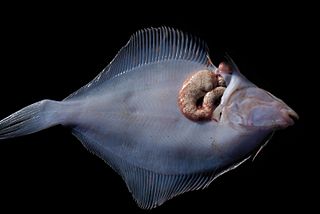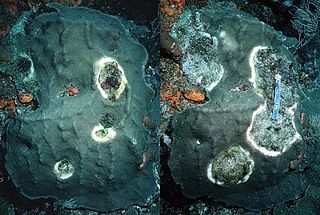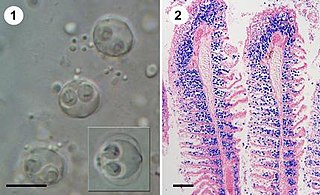
Myxozoa is a subphylum of aquatic cnidarian animals – all obligate parasites. It contains the smallest animals ever known to have lived. Over 2,180 species have been described and some estimates have suggested at least 30,000 undiscovered species. Many have a two-host lifecycle, involving a fish and an annelid worm or a bryozoan. The average size of a myxosporean spore usually ranges from 10 μm to 20 μm, whereas that of a malacosporean spore can be up to 2 mm. Myxozoans can live in both freshwater and marine habitats.

Myxobolidae is a family of myxosporean parasites which typically infect freshwater fishes, and includes the economically significant species, Myxobolus cerebralis. They have been shown to have a complex life cycle, involving an alternate stage in an invertebrate, typically an annelid or polychaete worm.
Tetracapsuloides bryosalmonae is a myxozoan parasite of salmonid fish. It is the only species currently recognized in the monotypic genus Tetracapsuloides. It is the cause of proliferative kidney disease (PKD), one of the most serious parasitic diseases of salmonid populations in Europe and North America that can result in losses of up to 90% in infected populations.
Kudoa thyrsites is a myxosporean parasite of marine fishes. It has a worldwide distribution, and infects a wide range of host species. This parasite is responsible for causing economic losses to the fisheries sector, by causing post-mortem "myoliquefaction", a softening of the flesh to such an extent that the fish becomes unmarketable. It is not infective to humans.

Chytridiomycosis is an infectious disease in amphibians, caused by the chytrid fungi Batrachochytrium dendrobatidis and Batrachochytrium salamandrivorans. Chytridiomycosis has been linked to dramatic population declines or extinctions of amphibian species in western North America, Central America, South America, eastern Australia, east Africa (Tanzania), and Dominica and Montserrat in the Caribbean. Much of the New World is also at risk of the disease arriving within the coming years. The fungus is capable of causing sporadic deaths in some amphibian populations and 100% mortality in others. No effective measure is known for control of the disease in wild populations. Various clinical signs are seen by individuals affected by the disease. A number of options are possible for controlling this disease-causing fungus, though none has proved to be feasible on a large scale. The disease has been proposed as a contributing factor to a global decline in amphibian populations that apparently has affected about 30% of the amphibian species of the world. Some research found evidence insufficient for linking chytrid fungi and chytridiomycosis to global amphibian declines, but more recent research establishes a connection and attributes the spread of the disease to its transmission through international trade routes into native ecosystems.

Sea lice are copepods of the family Caligidae within the order Siphonostomatoida. They are marine ectoparasites that feed on the mucus, epidermal tissue, and blood of host fish. The roughly 559 species in 37 genera include around 162 Lepeophtheirus and 268 Caligus species.

A xenoma is a growth caused by various protists and fungi, most notably microsporidia. It can occur on numerous organisms; however is predominantly found on fish.
Infectious hematopoietic necrosis virus (IHNV), is a negative-sense single-stranded, bullet-shaped RNA virus that is a member of the Rhabdoviridae family, and from the genus Novirhabdovirus. It causes the disease known as infectious hematopoietic necrosis in salmonid fish such as trout and salmon. The disease may be referred to by a number of other names such as Chinook salmon disease, Coleman disease, Columbia River sockeye disease, Cultus Lake virus disease, Oregon sockeye disease, Sacramento River Chinook disease and sockeye salmon viral disease. IHNV is commonly found in the Pacific Coast of Canada and the United States, and has also been found in Europe and Japan. The first reported epidemics of IHNV occurred in the United States at the Washington and the Oregon fish hatcheries during the 1950s. IHNV is transmitted following shedding of the virus in the feces, urine, sexual fluids, and external mucus and by direct contact or close contact with the surrounding water. The virus gains entry into fish at the base of the fins.

Ranavirus is a genus of viruses in the family Iridoviridae. There are six other genera of viruses within the family Iridoviridae, but Ranavirus is the only one that includes viruses that are infectious to amphibians and reptiles. Additionally, it is one of the three genera within this family which infect teleost fishes, along with Lymphocystivirus and Megalocytivirus.
Dermocystidium is a genus of cyst-forming, eukaryotic fish parasites, the causative agents of dermocystidiosis.

Streptococcus iniae is a species of Gram-positive, sphere-shaped bacterium belonging to the genus Streptococcus. Since its isolation from an Amazon freshwater dolphin in the 1970s, S. iniae has emerged as a leading fish pathogen in aquaculture operations worldwide, resulting in over US$100M in annual losses. Since its discovery, S. iniae infections have been reported in at least 27 species of cultured or wild fish from around the world. Freshwater and saltwater fish including tilapia, red drum, hybrid striped bass, and rainbow trout are among those susceptible to infection by S. iniae. Infections in fish manifest as meningoencephalitis, skin lesions, and septicemia.
The genus Labyrinthula is part of the protist group Labyrinthulomycetes and contains thirteen species. The major feature of this genus is the formation of an ectoplasmic net secreted by specialized organelles called bothrosomes which surrounds the colony, which is also used by Labyrinthula for moving. The protist reproduces by zoosporulation as it sets some flagellated spores free from a sporangium. One of the flagella of the zoospores has stiff tripartite hairs (mastigonemes) - the defining characteristic of the stramenopiles.
Hematodinium is a genus of dinoflagellates. Species in this genus, such as Hematodinium perezi, the type species, are internal parasites of the hemolymph of crustaceans such as the Atlantic blue crab and Norway lobster. Species in the genus are economically damaging to commercial crab fisheries, including causing bitter crab disease in the large Tanner or snow crab fisheries of the Bering Sea.

Yellow-band disease is a coral disease that attacks colonies of coral at a time when coral is already under stress from pollution, overfishing, and climate change. It is characterized by large blotches or patches of bleached, yellowed tissue on Caribbean scleractinian corals.

Kudoa is a genus of Myxozoa and the only genus recognized within the monotypic family Kudoidae. There are approximately 100 species of Kudoa all of which parasitize on marine and estuarine fish. Kudoa are most commonly known and studied for the negative effects the genus has on commercial fishing and aquaculture industries.

Colliniidae is a family of ciliates of the order Apostomatida.

Collinia is a genus of parasitoid ciliates of the Colliniidae family.

Philasterides dicentrarchi is a marine protozoan ciliate that was first identified in 1995 after being isolated from infected European sea bass reared in France. The species was also identified as the causative agent of outbreaks of scuticociliatosis that occurred between summer 1999 and spring 2000 in turbot cultivated in the Atlantic Ocean. Infections caused by P. dicentrarchi have since been observed in turbot reared in both open flow and recirculating production systems. In addition, the ciliate has also been reported to cause infections in other flatfishes, such as the olive flounder in Korea and the fine flounder in Peru, as well as in seadragons, seahorses, and several species of sharks in other parts of the world.

Enteromyxum leei is a species of myxozoan, histozoic parasite that infects the intestinal tract and sometimes associated organs, like gall bladder and liver, of several teleostean fish species. Myxozoans are microscopic metazoans, with an obligate parasitic life-style. The parasite stages of this species live in the paracelullar space between fish enterocytes. It is the causative agent of enteromyxosis, or emaciative disease, also known as "razor blade syndrome" in sparid fish. E. leei has a wide host and geographical range within marine fish, and even freshwater fish have been infected experimentally. E. leei initially emerged in the Mediterranean in the late 1980s and it is believed to have been unintentionally introduced into the Red Sea. Its pathogenicity and economic impact depend on the host species. In the gilt-head seabream, it is manifested as a chronic disease that provokes anorexia, delayed growth with weight loss, cachexia, reduced marketability and increased mortality. In other species, it has no clinical signs. In sharpsnout seabream, infection results in very high mortality rates, which have pushed fish farmers to abandon the culture of this fish species.

Sphaerospora molnari is a microscopic endoparasite of carp in pond cultures and natural freshwater habitats in Central and Eastern Europe. In natural infections, S. molnari invades the epithelia of gills and surrounding skin regions. It then forms spores in between epithelial cells, causing sphaerosporosis, a pathological condition of the skin and gill tissues. Affected tissues show marked dystrophic changes and necrosis, causing secondary bacterial infections and resulting in osmoregulatory and respiratory failure. Mortalities can reach 100% but little is known about the overall distribution of the parasite species in European carp ponds or its economic impact on carp aquaculture.












